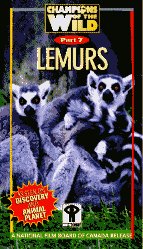|
________________
CM . . . .
Volume VI Number 14 . . . . March 17, 2000
Christian Bruyere & Ian Herring (Producers, Omni). George Johnson (Producer, NFB). Michael
Chechik (Executive Producer, Omni).
Grades 4 and up / Ages 9 and up.
These three videos about endangered animals have been shown on Discovery and Animal
Planet. Each follows a similar format which includes a brief dramatic opening designed to engage
the viewer's attention. This segment is followed by a number of images from the series and then
the title. All of the videos place approximately equal emphasis on the animal and the scientist (the
champion) studying the specific animal and the scientist's efforts at preservation of the animal
species. Although many details of the animals' lives are related, the focus is on their unique
features, particularly those that relate to environment and the threats to their survival. Information
on the scientists reveals how they came to be involved with their particular animal. The scientists
are shown engaged in conducting experiments and collecting data. Narration is provided by the
scientists and by an off-screen narrator.
The sound quality is excellent. The varied (close-up, distant, wide angle) images are of high
technical quality. In Sharks, which features Dr. Sam Gruber and Canadian photographer Tim
Calver, still images are interspersed with live action. The videos are accompanied by a helpful
summary of the video, pre- and post-viewing questions and three related Web sites.
Any one of these videos would be an effective introduction or conclusion to a unit on endangered
species. They could also be used to explore how animal behaviorists work.
Recommended.
Joan Simpson is the teacher-librarian at Dalhousie School in Winnipeg, MB.
To comment on this title or this review, send mail to cm@umanitoba.ca.
Copyright © the Manitoba Library Association.
Reproduction for personal use is permitted only if this copyright notice
is maintained. Any other reproduction is prohibited without
permission.
Published by
TABLE OF CONTENTS FOR THIS ISSUE - March 17, 2000.
AUTHORS |
TITLES |
MEDIA REVIEWS |
PROFILES |
BACK ISSUES |
SEARCH |
CMARCHIVE |
HOME
|



 Sharks has the least species specific content, perhaps because the topic is so broad. The
objective of Dr. Gruber is to destroy the Hollywood image of the shark and to create a respect for
the creature. His repeated statement that the shark is not "the death fish from Hell" and the vivid
image of the fins being hacked off a live shark may make this video unsuitable for young viewers.
Dr. Birute Galdikas's intense affection for the orangutans is demonstrated as she carries young
orangutans and berates people for the destruction of the rainforest. The human-like life cycle and
eating patterns of the orangutan are featured. Dr. Lisa Gould demonstrates an understanding of
the plight of the people of Madagascar and the lemur in her statements of the reasons for the
destruction of the lemurs' habitat. The matriarchial social structure and feeding patterns of lemurs
are featured. The videos also provide periods for quiet observation when live-action images are
accompanied only by natural sounds or unobtrusive background music.
Sharks has the least species specific content, perhaps because the topic is so broad. The
objective of Dr. Gruber is to destroy the Hollywood image of the shark and to create a respect for
the creature. His repeated statement that the shark is not "the death fish from Hell" and the vivid
image of the fins being hacked off a live shark may make this video unsuitable for young viewers.
Dr. Birute Galdikas's intense affection for the orangutans is demonstrated as she carries young
orangutans and berates people for the destruction of the rainforest. The human-like life cycle and
eating patterns of the orangutan are featured. Dr. Lisa Gould demonstrates an understanding of
the plight of the people of Madagascar and the lemur in her statements of the reasons for the
destruction of the lemurs' habitat. The matriarchial social structure and feeding patterns of lemurs
are featured. The videos also provide periods for quiet observation when live-action images are
accompanied only by natural sounds or unobtrusive background music.